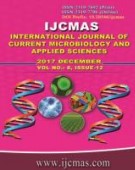


 National Academy of Agricultural Sciences (NAAS)
National Academy of Agricultural Sciences (NAAS)

|
PRINT ISSN : 2319-7692
Online ISSN : 2319-7706 Issues : 12 per year Publisher : Excellent Publishers Email : editorijcmas@gmail.com / submit@ijcmas.com Editor-in-chief: Dr.M.Prakash Index Copernicus ICV 2018: 95.39 NAAS RATING 2020: 5.38 |
There is an increased prevalence of dermatophytes over the past few decades. This study was done to isolate and identify dermatophytes in patients attending dermatology outpatient department in a tertiary care hospital. A total of 100 skin, hair and nail samples from clinically suspected cases of dermatophytosis of all age groups and of both sexes were collected and processed by KOH and culture on Sabouraud dextrose agar and Dermatophyte test media. Out of 100 clinically suspected cases of Dermatophytosis, commonly affected age group was 21-30 yrs. (M: F = 1.43:1). Culture positive cases were 40%. Sensitivity and Specificity for KOH and culture of all samples were 90% and 75% respectively. Distribution of clinical lesions based on site were Tinea corporis (31%), T. unguium (26%), T. cruris (25%), T. facei (6%), T. capitis (4%), T. pedis (4%), T. barbae (2%), T. manuum (2%). Frequency of various species of dermatophytes isolated by culture were Trichophyton tonsurans (42.5%), T. mentagrophytes (20%) T. verrucosum (20%), T. rubrum (7.5%), Epidermophyton floccosum (5 %), T. violaceum (2.5 %) and Microsporum gypseum (2.5%). To conclude, in this study, most common clinical type of dermatophytosis was Tinea corporis. Most common dermatophyte isolated from skin scrapings was T. tonsurans followed by T. mentagrophytes. Dermatophytes isolated from nail samples were T. verrucosum and T. tonsurans. Dermatophyte isolated from hair was T. violaceum.
 |
 |
 |
 |
 |